Matrix and Catalog Numbers in G&S Discography
By Howard S. Friedman
Table of ContentsSee Also:
- Gramophone Company Matrix and Catalog Numbers
- Victor Use of Matrix Numbers
- Matrix Numbers in Recordings of Gilbert & Sullivan
- Summary of Recording Histories
Introduction
This is the first part of a four-part article regarding the origins and uses of matrix and catalog numbers in Gilbert and Sullivan recordings. The second and third parts will be found in Gramophone Company Matrix and Catalog Numbers and Victor Matrix and Catalog Numbers. The fourth part will be found in Matrix Numbers in Recordings of Gilbert & Sullivan.
It is a remarkable coincidence that the première performances of Gilbert and Sullivan's fourteen collaborations — from the opening night of Thespis on December 26, 1871, to the closing night of their final effort, The Grand Duke, on July 10, 1896 — should have encompassed almost exactly the inventions of the tin-foil cylinder phonograph, the disc gramophone, and their respective recording processes. This series of articles deals with the concurrent evolution of the recording industry and the expanding discography of the Gilbert and Sullivan operettas and related works.
Many of the web pages on this site present detailed tables showing matrix and catalog numbers of recordings from the 78rpm era. Collectors and historians of old records have long known the importance of such numbers, but today a new generation of listeners is discovering these recordings, thanks to the popularity of CD re-issues. This article explains the origin and uses of these numbers in some depth. It is hoped that new aficionados of 78rpm records, as well as seasoned collectors, will find their study of these historical performances enhanced by a deeper understanding of this topic.
The information below has been gathered from many sources, from different periods and different types and volumes of resources and references. The ultimate reference for the discussion of matrix and catalog numbers is the matrix itself or, in lieu thereof, a pressing or impression derived from that matrix or from a copy of that matrix, and the catalog number printed on the label. What one writer has seen may not be available to another. Nor will all observers agree necessarily with the interpretation of the information found on any given matrix.
The introduction and perpetuation of glaring errors into a document such as this one can occur quite easily. A single example will suffice. The bibliography in John Wolfson's book, The Savoyards on Record, lists John R. Barnett's book, rather than John R. Bennett's book. This unfortunate error misleads the reader from one of the most important references in the discography of early vocal recordings, including many G&S sides. Since the Barnett book does not exist, this error is now disseminated throughout the community of G&S enthusiasts who, having read Wolfson's book, may have tried to locate that reference.
John Reginald Bennett's 9-volume compendium, Voices of the Past, is a major reference to English, Italian, French, German, and Russian vocal recordings between 1898 and 1925. These volumes, of which Volume 1 covers Berliner, Gramophone, Gramophone and Typewriter (G&T), and His Master's Voice (HMV) acoustical recordings, mainly in English, encompass more than 25,000 vocal recordings.
From the beginning of disc technology, recordings of Gilbert and Sullivan were made largely in London by the Gramophone Company and its successors. Also from about the beginning, the latter was associated very closely with the Victor Talking Machine Company and its successors. Each company often imported, repressed, and issued recordings of the other. This article will focus chiefly on the matrix and catalog numbering systems used by these two companies, as well as the interrelation between them.
This writer has twelve "complete" original sets of early 78rpm recordings of Gilbert & Sullivan operettas, on either HMV or Victor pressings or both, from the 1919 HMV Gondoliers (2 different copies) through the 1936 HMV Mikado, as well as some 210 different acoustical and 126 different electric 78rpm recordings. These include both single- and double-sided discs, on G&T, HMV, Victor, Victrola, and Red Seal, Columbia, Decca, and Zonophone labels. Among these are four 1902 single-sided G&T discs of Caruso recordings reissued on HMV 78s, the five Victor recordings of February 1906, and many early Gramophone & Typewriter, as well as Victor, single sides.
Examination of labels and of the unrecorded areas surrounding the labels of these early recordings provides much of the information presented herein. In addition, the manufacturers of LP and CD discs, especially Pavilion Records, Arabesque Records, EMI, and Symposium Records, provide informative liner notes. The information in the latter regarding both matrix and record numbers should be viewed with a critical eye. To illustrate this, one major company has listed a series of nine matrix numbers for recordings made in 1904, as 42580, 42590, 42600, 42610, 42620, 42630, 42640, 42650, 42660, and 42670. These numbers are far beyond any known matrix numbers in this series (see below). The correct numbers are 4259o to 4267o, the suffix indicating that these recordings had been made in Paris under the supervision of the recordist Cleveland Walcutt (see below).
James C. Lockwood, proprietor of 78s2CD, and Chris Webster, proprietor of Sounds on CD, have produced fine transfers of both acoustical and electrical G&S recordings. Liner notes included with their CDs provide many useful data. The former include photographs of disc labels from early acoustical sets, with matrix numbers below them.
There is "no possible doubt whatever," insofar as matrix markings are concerned, that seeing is believing. What you see is what you've got, regardless of what anyone else may say. With these caveats in mind, let us define the subject of this discussion.
Origin and Evolution of Matrix Numbers
Early Recording and Playback Equipment

|

|
One cannot dissociate the development of recordings on disc from that of the instrument for playing them — the one is useless without the other. This presentation will perforce include some historical background and progress of the individuals and companies concerned with both of these areas. I refer the reader to the references by Gelatt and by Read and Welch for more extensive details.
A matrix is a flat round plate upon which is etched, incised, or engraved a generally spiral groove containing information that can be converted to sound. The plate, or matrix, was developed largely by Emile Berliner, a native of Hanover, Germany, who came to the United States in 1870. While supporting himself with various odd jobs, he taught himself enough about electricity and acoustics to invent a microphone in 1877. In actual fact, Berliner's microphone transmitted sound very badly, and it was difficult, if not impossible, to discern words. Nevertheless, the sale of this instrument to the Bell Telephone Company gave Berliner the financial security and leisure to devote his attention to the problem of the recording and reproduction of sound.
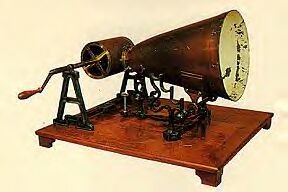 Leon De Martinville's Phonautograph 1857. From the Smithsonian Collection. The first instrument to record sound. |
Berliner was inspired by the phonoautograph, an instrument for recording sound on paper coated with lampblack on cylinders or drums, invented in France by Léon de Martinville in 1857, of which he probably saw an example at the Smithsonian Institution (right) in 1879, when he lived in Washington. After experimenting with various forms of drums and cylinders, Berliner finally realized that these had little future. (This conclusion was contrary to their inventor, Thomas Edison, who had experimented with disc recording and discarded it in 1878 in favor of cylinder recordings, which he continued until 1913. Edison provided cylinders to enthusiasts as late as 1929!)
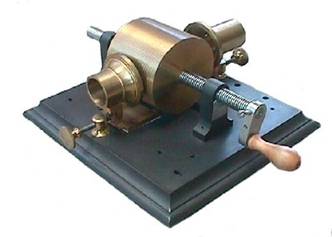 Edison's Tin-Foil Cylinder Phonograph The original instrument was fabricated by John Kruesi in Edison's Laboratory during December 2-6, 1877 |
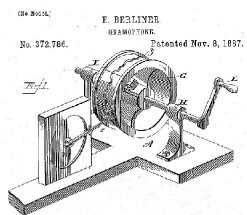 Berliner's Original Cylinder Recording Machine |
Berliner's first gramophone patent No. 372,786 (below) was applied for on May 4, 1887 and issued on November 8 of that year. This dealt with the lateral-cut recording of cylinders using lampblack applied to a "thin strip of paper, parchment, metal, or other suitable substance." According to Gelatt, Berliner applied for a patent for the glass disc recording and photoengraving process on September 26, 1887. Read and Welch (page 128) give the date as November 7, 1887, which is confirmed by examination of the patent itself (left). Berliner soon changed to a flat glass disc coated with lampblack, or carbon, deposited on a film of linseed oil. De Martinville had also used this medium on paper for his phonoautograph. Berliner's work was principally based on not only de Martinville's instrument of 1857, but also Thomas Edison's experimental discs of 1878, and Chichester A. Bell (Alexander Graham Bell's cousin) and Charles Sumner Tainter's 1886 patents for recording on discs.
To record, the disc or plate, as it was commonly called, was rotated under a needle or stylus mounted on a feed screw (a major point which Berliner derived from his study of the phonoautograph) to move the stylus laterally across the plate. This was diametrically opposed to Edison's hill-and-dale movement of the stylus, which moved vertically. The stylus was activated through a horn or tube by a source of sound (hence the term acoustical recording). In his patent application of November 7, 1887 (see below), the attached diagram of the recording instrument shows unmistakably that the stylus is beneath the glass plate. After the recording was completed, he "fixed" the disc by coating it with varnish. This could then be played back by reversing the original recording method, that is, allowing the needle or stylus used originally to make the tracing in the lampblack to retrace it and thus reproduce the original sound.
Berliner initially used a glass disc coated with lampblack, or carbon, deposited on a film of linseed oil. De Martinville had also used this medium for his phonoautograph. Berliner's work was principally based on not only de Martinville's instrument of 1857, but also Thomas Edison's experimental discs of 1878, and Chichester A. Bell (Alexander Graham Bell's cousin) and Charles Sumner Tainter's 1886 patents for recording on discs.
The recording method proved successful, but the sound reproduction was far from perfect. Berliner's greatest problem, however, was to prepare multiple copies of the original recording, so that they could be sold. To do this, he photoengraved the original matrix onto a metal plate, producing a "negative" matrix, from which multiple "positive" copies could be stamped.
Due to the great difficulty and unreliability of the photoengraving process, Berliner quickly discarded the glass disc in favor of a polished zinc plate, which he first coated with a solution of beeswax in benzene. When the benzene evaporated, a thin layer of wax remained, which could be cut by a laterally vibrating needle or stylus, as described above. After the recording had been completed, the wax was dissolved away, and the recording on the plate was "fixed," by dipping it into chromic acid. The disc or plate then became a matrix. Since the chromic acid ate away not only the metal surface exposed through the beeswax but also some metal on both sides of the groove, these early discs could be quite noisy.
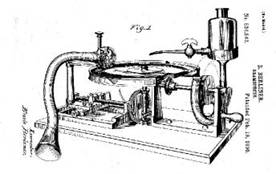 Berliner's Disc Recording Machine, November 7, 1887 |
Patent, No. 564,586, was applied for on November 7, 1887 and granted on July 28, 1896. It dealt with photoengraving after recording in "a layer of semifluid ink or paint," described by Berliner as basically lampblack in a fatty or oily solvent, usually linseed oil, applied to a glass disc. This patent was crucial in the development of the recording and playback processes that bear his name. He describes how the recording was made with the stylus beneath the glass disc (see the photo above), so that the lampblack particles removed by the stylus would fall away, rather than accumulate on the disc. This patent also describes the making of a metallic copy of the original plate, which is a photoengraved onto a copper plate, from which further copies or playable discs can be made. Berliner describes the stylus as phosphor-bronze, for which he substituted iridium, one of the hardest metals known, under Patent No. 534,543 in 1895. Lastly in this patent, Berliner describes the gramophone itself.
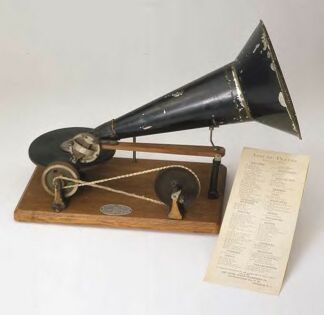 Berliner's 1887 Hand-Driven Gramophone |
The instrument for playing the recorded glass plate back was essentially the same as that used to record on the plate. That is, instead of moving the stylus across the plate by means of a feed screw, a necessary adjunct for playing back cylinders, it was allowed to traverse the groove and vibrate according to the undulations it had made previously during the recording phase. The sound itself was directed into a horn by means of a sound box, or diaphragm, mounted between the stylus and the horn. To distinguish his invention from Edison's tin-foil "phonograph" of February 19, 1878, Berliner named his instrument a "gramophone." Although the two terms were to become synonymous, the phonograph referred specifically to a talking machine employing vertical-cut cylinders, and later discs, while the gramophone played lateral-cut discs.
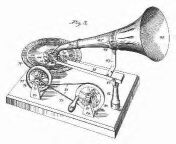 Berliner's hand-cranked gramophone from the original Patent No. 534,543 |
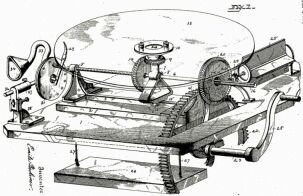 Berliner's Recording Gramophone, 1892 |
Patent No. 534,543, applied for on March 30, 1892 and issued on February 19, 1895, as shown on the identification plate below, was crucial to the playback process, since it described not only the construction of the gramophone itself (see at left) but also the fact that the walls of the grooves produced during the recording process were of sufficient depth and stiffness to guide the stylus across the disc during playback, without any supplemental mechanism. The original diagrams in the patent papers (left) show clearly, and with a detailed description, that a bottle of alcohol was suspended above the disc to be recorded, so that it dripped onto the disc during the recording process. Berliner stressed that this refinement was essential in removing any dust particles that might fall on the disc, as well as in facilitating the removal of the recording medium in front of the stylus.
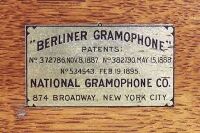 Berliner Gramophone Identification Plate 1895 showing three patent numbers |
The final patent No. 548,623, applied for on March 18, 1893 and issued on October 29, 1895, dealt with the method for producing a zinc/copper negative from the original zinc matrix, from which were pressed hard rubber and celluloid records. The patent history of the cylinder phonograph and the disc gramophone is extremely complex and drawn-out, and is best left to authorities like Koenigsbergand others.
By 1896, a solid wax disc had replaced Berliner's wax-coated zinc plate. History indicates that the developer of this advancement was Eldridge Reeves Johnson (later to become the founder of the Victor Talking Machine Company), although he never applied for a patent. Bell and Tainter had earlier (1886) concluded that wax was the most suitable medium for any matrix, cylindrical or flat. Perkins, Kelly and Ward refer to the "Johnson all-wax process," which pretty well establishes its source. Jerrold Moore, in his biography of Fred Gaisberg, confirms Johnson's invention. One may note that the wax used initially by Johnson in the development of his recording medium was derived from cylinder records purchased direct from Edison!Since it was no longer necessary to "fix" the recorded plate with chromic acid or any other substance, the masters or stampers (see below) could be made directly. Moreover, a much smoother groove could be cut in the wax, thereby eliminating much of the noisy surfaces produced by the chromic acid etching, and a much superior sound resulted. However, the use of wax-coated zinc plates was not discarded entirely. Sometime in early 1899, Berliner purchased the rights from Eldridge Johnson to the latter's new method of preparing stampers by electroplating the matrix.
One considerable advantage of the all-wax plate was its relative softness, allowing it to be cut more easily than the hard wax cylinders required by the Edison process. These were necessary because each recorded cylinder was an original, since no practical method of molding recorded cylinders had yet been developed.
The matrix has the same characteristics as a record or disc. That is, it can be played back with a stylus to reproduce the sounds inscribed on it. In order to make multiple copies, stampers or masters, or "negative" pressings, are prepared from each matrix. These can then be used to press individual "positive" discs. Since stampers undergo considerable wear, they were made of extremely hard materials, such as hard rubber, vulcanite, and finally a shellac composition manufactured by the Duranoid Company of Newark, New Jersey. This last, composed of shellac, lampblack, and byritis, with cotton flock as a binder, was used for 78rpm records well into the 1950's. (Note: this writer is deeply grateful to Emile Berliner for having selected hard rubber, and subsequently Duranoid, for making his final pressings. This writer dropped four early Gramophone records recently, and not one broke or cracked!)
By late 1902 Johnson had developed a 5-stage process for manufacturing records. This consisted of electroplating the original wax matrix, from which a negative master was prepared, which was also electroplated. From this many "mothers" (metal discs which are positive or playable, as opposed to the negative master and the stampers) could be made. The mothers were essentially duplicate or secondary matrices. From each mother one could make innumerable stampers, from which the final records were pressed. When a stamper wore out, after 500 or 600 pressings, a new one was produced from the mother, and the process could be continued. The 5-stage sequence was matrix - master - mother - stamper - record. Stamper indicators as high as 25D, meaning the 654th stamper from a single mother, have been seen.
Berliner licensed his patented processes, both for recording on flat plates and for playing them, to numerous recording companies, which proceeded to make recording instruments and recorded discs on a commercial basis. These included Edison's own National Phonograph Company and one of its subsidiaries, the Columbia Phonograph Company, as well as many others, in the United States; the Gramophone Company in England; and later in 1904, various other companies in Italy (Fonotipia), France (Pathé), Germany (Odeon), and other parts of the world.
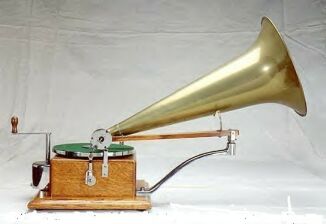 Berliner's 1896 Improved Gramophone with Johnson's Spring-Wound Motor |
Early History of the Gramophone Company
Early in 1894, Berliner offered a 21-year old man named Fred Gaisberg, who had been recording on cylinders for the Columbia Phonograph Company in Washington since July 1889, a similar job. Gaisberg, already adept at recording on cylinders, was amazed by the sound that could be obtained from disc recordings. Shortly thereafter, he moved his professional life to 1410 Pennsylvania Avenue, where in 1893 Berliner had formed the United States Gramophone Company, which held the patents, and there established a recording laboratory. The Berliner Gramophone Company was incorporated in Philadelphia on October 8, 1895, for the purpose of manufacturing gramophones.
In July 1897, Berliner sent his agent William Barry Owen to London, where in May 1898 he organized financial backing for and became the Managing Director of the Gramophone Company, which had exclusive rights (from Berliner) to sell gramophone instruments and records in Europe. A recording studio was set up at 31 Maiden Lane, The Strand, London, assembled from instruments provided by Eldridge Reeves Johnson (see above). On July 21, 1898, Fred Gaisberg, and his brother Will embarked for London, Owen having hired them as recording engineers or, as they were generally known in those days, recordists.
By May 1899, Owen had established the Deutsche Grammophon (DGG) branch of the Gramophone Company in Berlin, from which sub-branches were formed in Russia and Austria. These were followed by the Compagnie Française du Gramophone in Paris, and later by branches throughout the world.
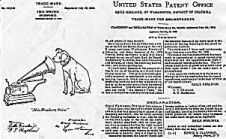 |
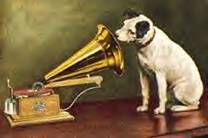 |
| Trademark Registration | "His Master's Voice" |
In September 1899, William Barry Owen purchased the famous "His Master's Voice" picture from the artist Francis Barraud, who later made 24 copies for the Victor Talking Machine Company. For some reason, this potentially important trademark did not appear on G&T labels until August 1910, although the Victor Talking Machine Company used it as early as 1904. A United States trademark (above) was registered to Berliner on July 10, 1900. (Note: Read and Welch say that Johnson registered the trademark! In fact, Berliner probably transferred the rights to the trademark along with other patent rights in 1901 (see below).) Later in 1900, Owen added a typewriter manufactory, and shortly thereafter he changed the name of the company to the Gramophone and Typewriter Company. Soon after this he introduced an electric clock. Both of these failed; fortunately, he did not change the company's name. By the end of 1904, Owen had sold his interest, resigned his directorship in the company, and retired to the United States to raise chickens on Martha's Vineyard. His departure ended the company's infancy and childhood, and it now entered adolescence.
The Gramophone Company was incorporated in England in 1899 as a limited company, renamed the Gramophone & Typewriter Company, Ltd. on December 10, 1900, and the Gramophone Company, Ltd. again in November 1907. It finally merged in 1931 with English Columbia to form Electric & Musical Industries (EMI) and became one of the most successful recording companies. The company is best known by the acronym "G&T," which has also been written "G & T," as well as "G. & T." For ease of writing and compactness, this discography prefers the use of G&T.)
By 1900 the Gramophone Company was able to advertise some 5,000 different recordings in a series of small catalogs listing English, Scottish, Irish, Welsh, French, German, Italian, Spanish, Viennese, Hungarian, Russian, and even Persian, Hindu, Sikh, Urdu, Arabic, and Hebrew records. In 1903 the London musical instrument firm of Barnett Samuel, which had been established in 1901, had a stock of 100,000 records and 60 different "talking machines," and was selling 3000 records a day!
Hitherto, recording artists, if they may be called such, consisted of actors, minstrel singers, comedians, ragtime players, shouters, and the like. Fred Gaisberg realized that the future of gramophone recording lay with the great classical music performers. This realization initiated his and the other recordists' worldwide trips in search of musical talent. Among his other functions, he was to become the first great talent scout, the original "A and R" man, of the gramophone industry. He was the chief recordist for the Gramophone Company from 1898 until the end of the acoustical era in mid-1925, and remained the senior recording expert for EMI until his death in 1951.
Fred Gaisberg was responsible for recording, at one time or another, most of the greatest musical celebrities of the first half of the last century. The list reads like a Who's Who of musical artists. They included:
- The singers Enrico Caruso, Adelina Patti, Emma Calvé, Celestina Boninsegna, Nellie Melba, Luisa Tetrazzini, Francesco Tamagno, Mattia Battistini, Antonio Scotti, Leo Slezak, Titta Ruffo, Giuseppe de Luca, Fernando de Lucia John McCormack, Lauritz Melchior, Beniamino Gigli, and the two great bassos Feodor Chaliapin and Pol Plançon;
- The pianists Wilhelm Backhaus, Alfred Cortot, Edwin Fischer, Walter Gieseking, Myra Hess, Sergei Rachmaninoff, Ignace Paderewski, Artur Schnabel, Artur Rubinstein, Vladimir Horowitz, Rudolf Serkin, and Arturo Michelangeli;
- The violinists Jan Kubelik, Fritz Kreisler, Jascha Heifetz, and Yehudi Menuhin;
- The great cellist Pablo Casals;
- The conductors Artur Nikisch, Arturo Toscanini, Bruno Walter, Adrian Boult, John Barbirolli, Wilhelm Fürtwängler, Fritz Busch, Felix Weingartner, Malcolm Sargent, Leopold Stokowski, and Georg Szell; not to mention,
- The Savoyards Richard Temple, Walter Passmore, Peter Dawson, Ernest Pike, John Harrison, Henry Lytton, Isabel Jay, and Amy Augarde, plus innumerable others.
One may note that in 1904, when Peter Dawson began to record for G&T, he was also making cylinders for their competitor, Russell Hunting, who was associated with Louis Sterling, and he later recorded the 1907 Russell Hunting Pinafore. Gaisberg and Hunting agreed that disc marketing and cylinder marketing were separate concerns, since a customer who owned one type of machine would probably not own the other!
Fred Gaisberg placed few if any of his artistic conquests under any sort of contract, but simply negotiated a fee for a set number of sides at any session. It was the Victor Talking Machine Company which took advantage of this lapse in commercial acuity, and signed most, if not all, of Gaisberg's artists, whom they then claimed as their own, to long-term contracts.
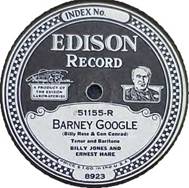
|
The label at right indicates the genre and quality of the selections which Thomas Edison proffered to the record buying public. Edison was tone-deaf, and had rather dreadful taste in what he considered entertainment. In 1912-1913 he conducted a European talent search to find vocal talent for his record company. His agents acquired over 300 cylinder recordings of some of Europe's greatest artists of that day. Each two-minute cylinder contained bits and pieces of musical works designed to provide Edison with some idea of the artist's abilities. In the end, Edison rejected all 300 or more cylinders and put them in storage! They were not opened again until 1999. These cylinders contain the sole record of many of the artists of that period.
Gramophone Company Matrix and Catalog Numbers.
Bibliography
Bennett, John Reginald. Voices of The Past. Vol.1. A Catalogue of Vocal Recordings from the English Catalogues, 1898-1925. Oakwood Press, 1956. (1978 Greenwood Press reprint.) ISBN 0-313-20237-0.
Bennett, John Reginald. Voices of The Past. Vol. 2. A Catalogue of Vocal Recordings from the Italian Catalogues, 1898-1925. Oakwood Press, 1957.
Bennett, John Reginald. Voices of The Past. Vol. 3. Vocal Recordings 1898-1925. Supplement to "Dischi Fonotipia." Oakwood Press, 1957.
Bolig, John Richard. The Recordings of Enrico Caruso, A Discography. Published by the Eldridge Reeves Johnson Memorial Delaware State Museum, Dover, Delaware, 1973.
Brooks, Tim, and Brian Rust. The Columbia Master Book Discography, Volumes I, II, III and IV. Westport, CT: Greenwood Press, 1999. ISBN: 0-313-29217-5 (entire set)
Chew, V. K. Talking Machines 1877-1914. Her Majesty's Stationery Office, London, 1967. SBN 11 290162 X.
Clough, Francis F., and G. J. Cuming. The World's Encyclopædia of Recorded Music, 1966. Sedgwick and Jackson, London. (Greenwood Press, Publishers, Westport, Connecticut 1975 reprint.) ISBN 0-8371-3003-4
Fagan, Ted, and William Moran. The Encyclopedic Discography of Victor Recordings: Pre-Matrix Series. Westport, CT: Greenwood Press, 1983. ISBN 0-313-23003-X.
Fagan, Ted, and William Moran. The Encyclopedic Discography of Victor Recordings: Matrix Series: 1 through 4999. Westport, CT: Greenwood Press, 1986. ISBN 0-313-25320-X.
Francis, John W. N. "The Gilbert and Sullivan Operettas on 78s." ARSC Journal, Volume 20, No. 1 (1988-1989).
Gelatt, Roland. The Fabulous Phonograph 1877-1977. MacMillan Publishing Co., Inc., New York, 1977. ISBN 0-02-542960-4.
Koenigsberg, Allen. The Patent History of the Phonograph, 1877-1912. Revised edition. Brooklyn, NY: privately printed by the author, 1991. ISBN 0-937612-13-8.
Moore, Jerrold Northrop. A Matter of Records: Fred Gaisberg and the Golden Era of the Gramophone. Taplinger Publishing Company, New York, 1977.
Moses, Julian Morton. Collector's Guide to American Recordings 1895-1925. Dover Publications, Copyright 1949 by the American Record Collectors' Exchange.
Perkins, John, F., Alan Kelly, and John Ward. "On Gramophone Company Matrix Numbers 1898 to 1921." Published in The Record Collector, Ipswich, Suffolk, England, Vol. XXIII, Nos. 3 & 4, May, 1976.
Read, Oliver, and Walter L. Welch. From Tin Foil To Stereo. Howard W. Sams & Co, Inc., Indianapolis, 1976. ISBN 0-672-21206-4
Smith, Michael, compiler. The Gramophone Company Ltd His Master's Voice Black Label 12 & 10-inch "D" & "E" 78 rpm Series. Witley Press, Hunstanton, England.
Sutton, Allan, and Kurt Nauck. American Record Labels and Companies, An Encyclopedia (1891-1943). Mainspring Press, Colorado, 2000.
Wolfson, John. The Savoyards on Record. Packard Publishing Limited, Chichester, England, 1985.
